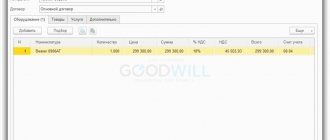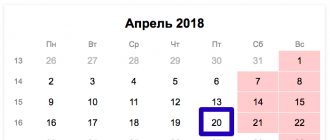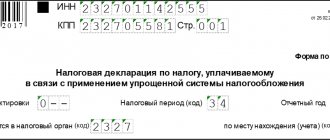On September 9, 2021, the order of the Federal Tax Service of Russia dated August 19, 2020 No. ED-7-3/591, registered with the Ministry of Justice, was officially published, which approved the new form of the value added tax declaration. This update of the VAT return form is the tax authorities’ reaction to the changes in legislation that have occurred. In addition to changing the form itself and the electronic format, changes have been made to the procedure for filling out the VAT return. We tell you what has changed .
What's new in the VAT return form
By Order of the Federal Tax Service dated August 19, 2020 No. ED-7-3/591 (registered with the Ministry of Justice on September 9, 2020), a new form of the VAT declaration form was introduced.
The order is quite lengthy, but most of it is devoted to technical details related to the mandatory electronic form for submitting the declaration. In this material, we will not dwell on them in detail, since technical innovations will be taken into account by both accounting software developers and EDI operators. Let's go through the semantic changes.
What has changed in the new VAT return?
There are no fundamental amendments to the VAT return, they are targeted. The reporting has changed:
- title page;
- section 1;
- sections with data from invoice journals and purchase and sales books;
- list of transaction codes (not recognized as an object of taxation, exempt from taxation, taxed at a zero rate).
Let's consider all the adjustments made to the updated declaration form in more detail.
Title page
The line “Code of the type of economic activity according to the OKVED classifier” was removed from the first sheet of the reporting form. This is what the modified sheet looks like:
The barcodes of all declaration sheets have changed. For title - 0031 2011.
Section 1
In the section “Amount of tax subject to payment to the budget (reimbursement from the budget) according to the taxpayer”, lines were added for taxpayers who have entered into an agreement on the protection and promotion of investments (SZPK):
- 085 - a sign of concluding an agreement on the protection and promotion of investment;
- 090 - to reflect the amount of VAT payable by a taxpayer who is a party to the SZPK;
- 095 - to reflect the amount of tax calculated for reimbursement from the budget by a taxpayer who is a party to the SZPK.
They are filled out only by payers officially recognized as a party to the SPPK.
Operation codes
For preferential transactions that are not recognized as subject to VAT or are exempt from taxation (taxed at a zero rate), new codes have been introduced:
- 1010831 - to designate an operation to transfer, free of charge, property intended for use to prevent and prevent the spread of a new coronavirus infection, for the diagnosis and treatment of covid patients, to state authorities and management, local governments, state and municipal institutions, state and municipal unitary enterprises ;
- 1011450 - to designate the operation of transferring real estate free of charge to the state treasury of the Russian Federation;
- 1011451 - to indicate the transfer of property for organizing and/or conducting scientific research in Antarctica into the ownership of the Russian Federation free of charge;
- 1011208 - to indicate operations for the sale of municipal solid waste (MSW) management services provided by MSW management operators in the regions of the Russian Federation;
- 1011446 - to reflect the sale of international air transportation services at international airports of the Russian Federation, according to the list approved by the government.
New codes have been added to Appendix No. 1 to the Procedure for filling out a VAT return. Previously, tax officials recommended using these codes in letters. Now they are systematized. Additionally, new codes for taxable and non-taxable transactions have been introduced for taxpayers in the IT sector. A number of codes were brought into line with the terms and provisions of the Tax Code of the Russian Federation.
Columns have appeared for entering data on SZPK
First, let us recall what SZPK is.
REFERENCE
The CPP is an agreement to protect and encourage investment. Namely, an agreement between the state (RF) and a private investor investing in an investment project.
Between an investor (for example, a private company) implementing an investment project (IRP), on the one hand, and one or more government entities, on the other hand, an SPPK may be concluded, according to which the public party (government entities) guarantees the private party (firm ) not apply to the project acts that may worsen the conditions for its implementation.
EXAMPLE
If the basic income tax rate on the date of conclusion of the SZPK is 20%, then even if it is increased in relation to all taxpayers, for the ORP it will still remain at the level of 20% (in relation to profit from the investment project).
Similarly, acts that increase the time or number of procedures required for the implementation of an investment project will not be applied to the SZPK participant.
All provisions were introduced by the Law “On the Protection and Encouragement of Investments in the Russian Federation” dated 04/01/2020 No. 69-FZ.
To inform tax authorities that the taxpayer has rights to a “stable” tax rate, new columns have been introduced in section 1 of the VAT return.
New form of VAT declaration
The Federal Tax Service of Russia, by order No. ED-7-3/ dated August 19, 2020, approved a new form, electronic format and procedure for filling out a value added tax declaration. The document has not changed completely, new fields have simply been added to it, therefore the changes were made to the Federal Tax Service order No. ММВ-7-3/ dated 10.29.2014. They were required in connection with amendments to the Tax Code of the Russian Federation by two laws:
- Federal Law No. 69-FZ dated 04/01/2020;
- Federal Law No. 70-FZ dated 04/01/2020.
The amendments are not massive; they relate to investment activities and capital investments. For organizations implementing investment projects, the tax regime in force at the time the agreement on the protection and promotion of investment came into force was retained. In this regard, such taxpayers were required to keep separate records of income and expenses received (incurred) in the implementation of agreements on the protection and promotion of capital investments and other activities. The report on the amounts of tax benefits has been abolished; separate VAT accounting is now reflected directly in the declaration.
When does the updated form come into effect?
A new VAT form is used for reporting for the 4th quarter of 2020 and beyond, until further amendments are developed and approved.
Use free instructions from ConsultantPlus experts to correctly fill out the new VAT return form.
New codes
Quite a lot of new codes have been added, most of them relating to VAT-exempt transactions.
For some old codes, the wording was brought into line with the new ones added. For example, after the appearance of code 1011210 (sale of food products by medical institutions), the word “medical” was removed from the decoding of code 1010232 (now only sales of food products in educational institutions remained there).
VAT return for the fourth quarter: new form
No later than January 25
you need to submit
a VAT return for the fourth quarter of 2021
using the new form approved by Order of the Federal Tax Service dated August 19, 2020 N ED-7-3/ [email protected]
For most companies, there are no significant changes in the updated version. The barcodes on all pages have been corrected, and the OKVED code has been removed from the title page. In the first section, lines have appeared to indicate information in connection with the agreement on the protection and promotion of investments (SPPK), and there are amendments in the lines of other sections. The procedure for filling out the declaration has also been updated.
All companies must fill out the title page, sections 1, 3, 8 and 9. The remaining sections are intended for specific operations. For example, tax agents need to fill out section 2 if municipal property was rented, section 7 - when performing VAT-free transactions.
Sections 8 and 9 are completed based on the purchase and sales books. Attachments to sections are needed only when submitting an updated declaration.
Section 3 calculates tax on ordinary transactions. It does not need to indicate non-taxable transactions and transactions at a zero rate. The section is filled out as follows:
- in lines 010 - 118 - accrued VAT and recovery tax;
- in lines 120 - 190 - tax deductions;
- in lines 200 and 210 - the final indicators for the third section.
As for the appendices to the third section, 1 is filled out only when restoring VAT on real estate, and 2 – for foreign organizations.
Section 1 reflects the amount of VAT payable or refundable, indicating the OKTMO code at the place of payment of VAT and BCC.
When submitting a declaration, the adjustment number “0—” is entered on the title page for the first time; in the updated declaration, “1—” (and so on). The tax period in the VAT return for the fourth quarter is “24”, the reporting year is “2020”.
After filling out the VAT return, it is recommended to check it against the control ratios in order to avoid inaccuracies in the indicators. When generating a declaration using an accounting program, some fields are filled in automatically, which helps avoid errors.
If in the 4th quarter of 2021 the company did not carry out any activities and did not accept VAT for deduction, a zero declaration should be submitted. Only the title page and the first section are filled in.
We recommend : “New form of VAT declaration”
Document:
ConsultantPlus: free access
Fill out the form and get access to the free demo version of ConsultantPlus
! The system contains legislative documents, latest news, expert comments, recommendations, samples of filling out declarations and calculations, ready-made solutions, etc.
We prepare VAT reports for the 4th quarter of 2021
Let's remember the basic rules for filling out a VAT return:
- The title book and section 1 are prepared by everyone who is required to report VAT.
- Complete sections 2–12, as well as appendices to sections 3, 8–9, only if you have had relevant business operations. If there were none, do not attach blank sheets to the report.
- Sections 8–9 are prepared by VAT payers who keep books of purchases and sales. Sheets 8–9 will contain all the information from these registers, including adjustments and corrections.
- Sections 10–11 are for intermediaries, including VAT evaders. These sheets are identical to sections 8–9, but the information for them is taken from a different source - the invoice journal.
- Section 12 is the prerogative of VAT non-payers who issue invoices with a tax line indicated. Those who do not pay tax (or are exempt from it), in the case of issuing a VAT invoice, submit to the controllers a declaration consisting of title, sections 1 and 12.
A sample VAT return for the 4th quarter of 2021, completed based on the example, can be downloaded in the material “What is the procedure for filling out a VAT return (example, instructions, rules).”
IMPORTANT! When filing a VAT tax return, check whether the transaction type codes (KVO) are entered correctly in the VAT tax registers. Inconsistencies in the accounting standards entered in the books of purchases, sales and invoice journals will lead to the fact that the reporting will not pass the format and logical check and will be considered as not submitted.
VAT declaration is one of the most complex. However, even a serious problem can be dealt with if you have competent professional support nearby.
The sections of the VAT return for the 4th quarter of 2021 will help you fill out the recommendations of our experts:
- “What is the procedure for filling out a VAT return (example, instructions, rules)”;
- “How to correctly fill out a VAT return for a tax agent?”;
- “How to fill out line 090 of section 3 of the VAT return”;
- “How to fill out line 030 of section 3 of the VAT return”;
- “Section 7 of the VAT return”;
- “How to fill out line 080 of section 2 of the VAT return”;
- “What is reflected in line 170 of the VAT return in 2017-2018?”;
- “How to correctly fill out section 4 of the VAT return when applying a 0% rate?”.
And if you practice separate accounting, take a look here. Before sending the report, do not forget to check the correctness of its completion, using the accounting registers and control ratios recommended by the Federal Tax Service. Otherwise, it is possible that the reporting will not be accepted, and tax authorities will not hesitate to impose fines.
Deadlines for submitting VAT returns
The VAT declaration is submitted to the Federal Tax Service quarterly in electronic form, no later than the 25th day of the month following the expired quarter (clause 5 of Article 174 of the Tax Code of the Russian Federation). In 2021, the declaration must be submitted within the following deadlines:
- for the fourth quarter of 2021 - no later than 01/27/2021;
- for the first quarter of 2021 - no later than 04/26/2021;
- for the second quarter of 2021 - no later than July 26, 2021;
- for the third quarter of 2021 - no later than November 25, 2021;
- for the fourth quarter of 2021 - no later than 01/25/2022.







